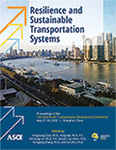13th Asia Pacific Transportation Development Conference
Passenger Behavior Characteristics-Based Research on Beijing “One City, Two Airports” Air Traffic Assignment under the Beijing-Tianjin-Hebei Coordination Strategy
Publication: Resilience and Sustainable Transportation Systems
ABSTRACT
After the construction completion of the Beijing new airport, based on the increasingly mature and integrated ground transportation, the research on the aviation market demand distribution of the regional airport system based on passenger behavior characteristics has been significant for Beijing to explore the cooperation mode of “one city, two airports”. Based on the background of Beijing-Tianjin-Hebei coordination strategy, this thesis firstly analyzes air passenger behavior attribute characteristics in Beijing-Tianjin-Hebei region from three aspects including passenger personal characteristics, passenger travel characteristics, and aviation activity selection behavior characteristics. Secondly, the passenger group is divided into business travelers and leisure travelers, and then this thesis constructs a two-layer nested Logit model of the selected airports, and finally predicts the radiation area and air traffic assignment of “one city, two airports” of Beijing. The results show that: (1) in terms of passenger behavior characteristics, the top preference of business travelers is flight frequency, while it is flight fare for leisure passengers, and the on-time rate is a common concern factor for both business and leisure travelers. (2) Both airports in Beijing radiate cities including Beijing, Tianjin, Tangshan, Langfang, Baoding, and Cangzhou. (3) After the operation of the new airport, passenger flow of PEK will be diverted to ease its operational pressure on one hand, and it will also expand the aviation radiation area of Beijing and promote the competitiveness of Beijing as an international aviation hub.
Get full access to this article
View all available purchase options and get full access to this chapter.
REFERENCES
Adler, T., Falzarano, C. S., and Spitz, G. (2005). “Modeling service trade-offs in air itinerary choices.” Transportation Research Record, 1915(1), 20-26.
Başar, G., and Bhat, C. (2004). “A parameterized consideration set model for airport choice: an application to the San Francisco Bay area.” Transportation Research Part B: Methodological, 38(10), 889-904.
Wang, C. E. (2010) “The analysis of characteristic and behavoir flight passenger in changchun.” Jilin, Jilin University.
de Luca, S. (2012). “Modelling airport choice behaviour for direct flights, connecting flights and different travel plans.” Journal of Transport Geography, 22, 148-163.
Garrow, L. A., Kressner, J., and Mumbower, S. (2011). “Is increasing airline denied boarding compensation limits the answer? Factors that contribute to denied boardings.” Journal of Air Transport Management, 17(5), 271-277.
Mei, H., Zhu, J. F. and Wang, X. (2007) “Structural characteristics and trends of airline passenger choice behavior in China.” Journal of Commercial Economics, 2007(5), 95-97.
Hess, S., and Polak, J. W. (2005). “Mixed logit modelling of airport choice in multi-airport regions.” Journal of Air Transport Management, 11(2), 59-68.
Johnson, D., Hess, S., and Matthews, B. (2014). “Understanding air travellers' trade-offs between connecting flights and surface access characteristics.” Journal of Air Transport Management, 34, 70-77.
Wang, K., Zhu, X. H., and Zhu, J. F. (2012) “Research on travel choice behavior of regional airline passengers.” Journal of Shanxi University, 35(03), 478-482.
Pels, E., Nijkamp, P., and Rietveld, P. (2003). “Inefficiencies and scale economies of European airport operations.” Transportation Research Part E: Logistics and Transportation Review, 39(5), 341-361.
Proussaloglou, K., and Koppelman, F. S. (1999). “The choice of air carrier, flight, and fare class.” Journal of Air Transport Management, 5(4), 193-201.
Thompson, A. and Caves, R. (1993). “The projected market share for a new small airport in the North of England.” Regional Studies, 27(2), 137-147.
Chen, W. Z., Huang, J. C., Yan, M., and Zhang, J. Y. (2012). “Research on the characteristics of Beijing passengers and the distribution rate of new airport.” Progress in Geography, 31(10), 1360-1368.
Warburg, V. (2005). Modeling air travel behavior. BS thesis. Technical University of Denmark, DTU, DK-2800 Kgs. Lyngby, Denmark.
Wen, C. H. and Lai, S. C. (2010). “Latent class models of international air carrier choice.” Transportation Research Part E: Logistics and Transportation Review, 46(2), 211-221.
Windle, R. and Dresner, M. (1995). “Airport choice in multiple-airport regions. Journal of Transportation Engineering, 121(4), 332-337.
Liu, X. M. and Xia, H. S. (2008) “A literature review of the study on airport choice.” Application of Statistics and Management, 2008(5), 898-903.
Information & Authors
Information
Published In
Resilience and Sustainable Transportation Systems
Pages: 246 - 254
Editors: Fengxiang Qiao, Ph.D., Texas Southern University, Yong Bai, Ph.D., Marquette University, Pei-Sung Lin, Ph.D., University of South Florida, Steven I Jy Chien, Ph.D., New Jersey Institute of Technology, Yongping Zhang, Ph.D., California State Polytechnic University, and Lin Zhu, Ph.D., Shanghai University of Engineering Science
ISBN (Online): 978-0-7844-8290-2
Copyright
© 2020 American Society of Civil Engineers.
History
Published online: Jun 29, 2020
Authors
Metrics & Citations
Metrics
Citations
Download citation
If you have the appropriate software installed, you can download article citation data to the citation manager of your choice. Simply select your manager software from the list below and click Download.
